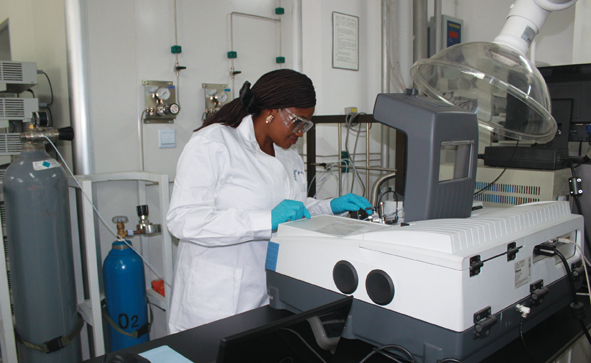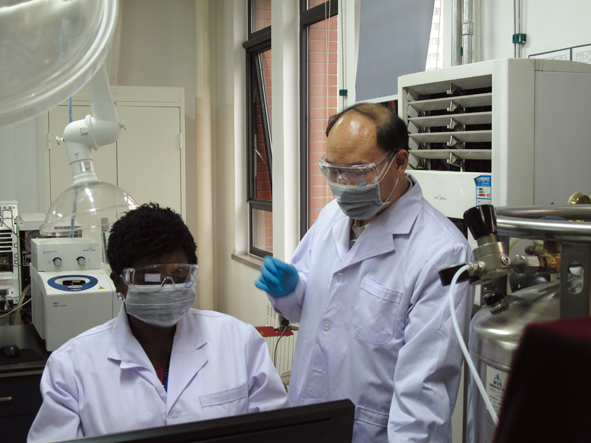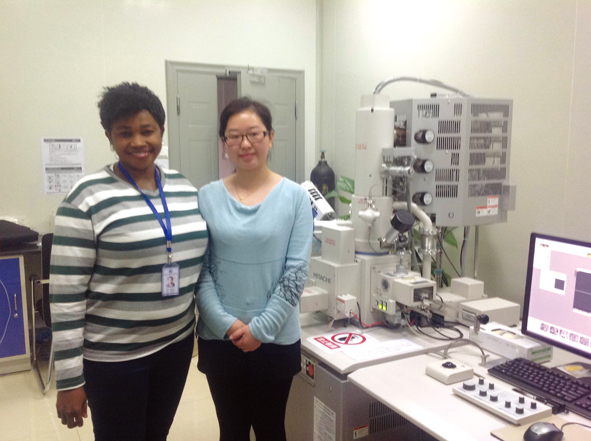By SONG Jianlan (Staff Reporter)
In a lab of the CAS Institute of Process Engineering (IPE) in Beijing, Winifred Uduak Anake, a visiting woman scientist from Covenant University, Nigeria was dashing to finish testing the 100 plus samples she collected from her home country. “I am trying to find out the type and amount of hazardous trace metals bound to the tiny particles trapped on the filters,” she explained: “out of worries about their possible threat to human health.”
Before concluding her three-month stay she needed to complete examining the morphology of the particles, total trace metals, and chemical speciation for bioavailable metals using scanning electron microscope coupled with an energy dispersive X-ray system (SEM-EDX), wavelength dispersive X-ray fluorescence spectrometer (WDXRF), microwave accelerated reaction system (MARS), and inductively coupled plasma mass spectrometry (ICP-MS).
She was anxious to finish all the complicated work before going back to Nigeria, where she would not have adequate/sufficient infrastructure and technological aid to do the necessary tests.
Passionate Pursuit
Anake won a scholarship sponsored by the CAS-TWAS Centre of Excellence on Green Technology (CEGT, http://cegt.ipe.ac.cn), an entity based in IPE and jointly operated by CAS and the World Academy of Sciences for the advancement of science in developing countries (TWAS), to support her study at IPE. Named CEGT Scholarship, the program aims to promote the development of green technology, as well as the transformation of scientific achievements in developing countries.

Anake working in a lab at the CAS Institute of Process Engineering (IPE) in Beijing. (Photo by courtesy of CEGT)
Now with access to state-of-the-art experiment equipment and techniques here, eventually Anake got a chance to unravel the mystery seated in the extremely tiny particles, which had long troubled her.
“My research skills have been sharpened, through exposure and access to sophisticated analytical instruments. I believe this will make the research work visible in high-impact journals,” Anake commented on her study and work at IPE with optimism, in a talk with the author occurring in late October 2015, days before her flying back to Nigeria.
A chemist seeking to solve environment problems that border on human health, Anake is very concerned about the health effects of the tiny particles in the atmosphere — known as PM2.5 due to their grain sizes less than 2.5 μm — generated by mixed sources, including the booming industries in her country.
“We have lots of industries in Nigeria, like oil recovery and petrochemical, metal melting, cement production, construction and others. Yes, they create wealth, but in the mean time they also cause problems: they produce PM2.5 with pollutants adhering to them. Therefore while formulating the research for my PhD thesis, I want to do something to deal with this, ” she explained.
Even in the vicinity of the place where she is studying, the Covenant University in Ota of Nigeria, Anake narrated, they have a lot of industries. The landscapes have prompted her to pursue research to track the particles, in the hope of finding out if any connection exists between the pollutants and increased occurrence of respiratory diseases. “We are very concerned because there is no emission control of such pollutants. Nor is there any suitable solution to trap the particles.”

Anake in lab with her host at IPE, CAS Member Prof. ZHANG Suojiang. (Photo by SONG J.)
“They are thinner than hair size and can be inhaled by people. They go straight to the lungs, and get stuck in the organs of the body. What makes it worse is the fact that they are not just particles. They have pollutants adhering to it, including trace metals, some of which are carcinogenic. ”
Noting the dearth of data showing chemical speciation and health risks associated with PM2.5 particulates, especially from heavily industrialized areas, and no convincing evidence on the part of regulatory bodies to enforce stricter emission limits, she began to take action.
Anake found some signs of connections between the particles and increased cases of respiratory diseases in her search for relevant literature. Further, she heard some bitter complaints from the residents in the environments of the sampling sites during her sample collection. “They complained of the incessant emission of noxious chemicals, which caused itching on the throat, coughing, and irritation of the eyes amongst others. This is most disturbing, especially for the sensitive groups, namely patients of asthma, the elderly, and the children,” she recalled. “If you check with nearby hospitals, ” she continued: “you can see frequent challenges, mostly at peaks of such emissions.”
Temporary Barriers
Determined to embark on her exploration, she realized that she needed to better understand the compositions of the particles. At this point, the unavailability of the needed instruments posed a grave challenge to the analysis of the research samples.

Anake and her experiment teacher at IPE. (Photo by courtesy of Anake)
“We do not have the necessary research infrastructure to do such scientific tests, ” she narrated.
According to Anake, presently in Nigeria, although one can find some of the facilities in oil and gas companies, there is no research institute hosting necessary equipment for research aimed at PM2.5 pollutant tracking and control.
“Already our university has interactions with some industries and there is hope of establishing more collaboration. Until that succeeds, we cannot work in their labs nor do analysis of this nature. One of the options is to look for collaboration with research institutes in countries that have access to such facilities.
“Therefore I turned to Prof. ZHANG for help,” she continued on the story, smiled when mentioning her host, CAS Member Prof. ZHANG Suojiang, who is currently head of both IPE and CEGT.
A Hand in Need
She found ZHANG through a special contact — a CAS-TWAS Fellowship alumnus at her university.
“We have a CAS-TWAS Fellowship alumnus in our university by name Dr. Abiodun Humphrey Adebayo. He maintains in contact with Mme FU Shuqin at TWAS Beijing Office, and they both helped in connecting me with a suitable host, Prof. ZHANG, ” Anake smiled recalling the details how she came all the way to IPE.
Dr. Adebayo won a CAS-TWAS Fellowship for Postgraduate Students to spend one year at the CAS Kunming Institute of Botany between March 2008 and February 2009, and later a CAS-TWAS Fellowship for Visiting Scholars to do his post-doctoral research at the CAS Institute of Microbiology1. His experience with CAS and TWAS has in turn brought opportunities for the people around him.

Samples collected and prepared by Anake. (Photo by courtesy of Anake)
“Indeed ZHANG happens to be the world’s most excellent host,” Anake continued her story. “He is prompt at providing all my research needs. With the required research tools and his mentorship role, I saw the short duration of my visit, coupled with two holidays in between, as a motivation to work round the clock for my desired results,” she emphasized.
“The door to my research in China, and most importantly at IPE, opened timely through God divine intervention,” she continued with thankfulness: “For this opportunity I will eternally be thankful to Mme Fu, my host Prof. ZHANG Suojiang, and Dr. Abiodun Humphrey Adebayo.”
“The people in IPE have been wonderful, welcoming and very willing to assist,” Anake described her life in Beijing in an exciting tone: “They make me feel at home. I’ve made new friends, visited a few tourist resorts like the Great Wall, the Summer Palace, and top universities in Beijing including Peking University and Tsinghua University. I’ve also learnt how to use the subway, and handle chopsticks!”
“She leaves the lab very late every night,” Prof. ZHANG Suojiang thought highly of this hard-working student: “She has a lot to learn in the lab, and she has over 100 samples to test, which is a lot for a short-term visit lasting for only three months; but she will make it, judged from her progress.”
Particularly, ZHANG was impressed by Anake’s passion and determination. “She is an excellent scholar who is very clear about what to do in her research to pursue her goal. First time we met, I presented her with a preliminary research plan on CO2 capture using ionic liquid based materials, but she insisted on pursuing her goal to investigate the composition of her already collected PM2.5 samples. I immediately agreed, and decided to give her our full support; we realized that she had very mature ideas on her own research already.”
According to her research proposal, Anake wants to determine the spatio-temporal variability and bioavailability of PM2.5 metals such as As, Cd, Cr, Ni, Co, Pb, Mn, V, etc., and to identify the pollutant sources as well as their associated health risk on residents in Ewekoro, Ota and Agbara industrial estates in Ogun state, Nigeria.
With her clearly designed research plan, Anake came to IPE in Beijing in late July 2015. Before coming, she managed to collect over 100 PM2.5 samples from selected sites of different industries — every sample collected on Teflon or glass fiber filters in line with standard methods with environtech gravimetric sampler — despite unimaginable difficulties, including absence of funding.
“It took me six months to collect them, covering both dry and rainy seasons,” introduced Anake.
It is hard to imagine how this gentle, decent and beautiful woman coped in the vicinity with thick black, whitish and grayish emissions from chimneys of metal smelting, cements and scrap recycling industries, or emission from combined activities of other numerous industries, such as chemical and pharmaceuticals, basic metal, iron and steel and fabricated metal products, building and construction. It would be even more difficult to imagine how she encountered threats and hostility from some security personnel from the industries who would rather dam the dirty truth behind their walls, and the local area boys who see such continuous research outing as an opportunity to make money. She was resilient, however, stood unshaken and stuck to her goal, even in the circumstance she had to pay for the sampling herself.
“Many scholars in developing countries including Nigeria find it difficult to do research and a number of them have to use their personal funding to pursue science due to lack of support from the government and other agencies,” she said.

“My most excellent host.” Anake poses with Prof. ZHANG at IPE before leaving for home. (Photo by SONG J.)
Common Concern
“Next time maybe you can collect some samples from different regions of China,” suggested Prof. ZHANG: “Your research represents a common concern of developing countries: We share the same problem. Probably we can conjure a joint research plan and submit it to TWAS office, as it is a very important issue for the developing world.”
ZHANG’s institute is among the many institutions in China dedicated to solving such environmental problems. Particularly IPE focuses on fundamental and applied research on green industrial processes that might catalyze a revolution in high-efficiency transformation and substitution of resources, to boost the country’s switch to a less energy-consuming and cleaner track of manufacturing, which could be the ultimate way to curb dust-haze and pollution, as believed by experts. To help promote green technology development and commercialization in developing countries, and to enhance reciprocal cooperation between China and other developing countries in the field of green technology, CEGT launched the CEGT Scholarship, hoping to help incubation of talents and business. Every year, the Scholarship supports one to two excellent postgraduate students from developing countries to pursue their PhD degrees at IPE, and two to three outstanding scholars from developing countries for short-term visits each lasting for three to six months. The Scholarship is now open for online application (http://cegt.ipe.ac.cn/edu/sch/fours/).
“We welcome excellent young scholars like Anake,” Prof. ZHANG smiled.
“Aside from the Scholarship, we are considering the offer of remote service of sample analysis and characterization, including X-Ray Diffraction (XRD) and X-Ray Photoelectron Spectroscopy (XPS) tests, to help in overcoming similar difficulties faced by developing countries,” added Prof. ZHANG. “In due time this service will be available online and open for scholars from developing countries to apply. From the applicants we will select a certain number to support after a review of their proposals. We will help them testing the samples, and also the delivery to and from China, for free, if necessary funding in place and appropriate procedures formulated,” he continued.
Actually, a grand program implemented and funded by CAS might also provide some opportunities for cooperation. CAS has initiated a Priority Strategic Program to track the sources of PM2.5 and investigate the triggering mechanism of dust-haze. Under the umbrella of this big program, a series of projects are arranged, targeting different issues.
Those who sowed in tears shall reap in joy. Hope is dawning.

